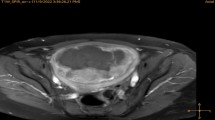Abstract
Purpose
The aim of this study was to assess the feasibility and effectiveness of magnetic resonance (MRI)-guided focused ultrasound (MRIgFUS) ablation for uterine fibroids and to identify the candidates for this treatment.
Materials and methods
A total of 48 patients with a symptomatic uterine fibroid underwent MRIgFUS. The percent ablation volume was calculated, and the patients’ characteristics and the MR imaging features of the fibroids that might predict the effect of this treatment were assessed. Changes in the symptoms related to the uterine fibroid were assessed at 6 and 12 months.
Results
The planned target zone were successfully treated in 32 patients with bulk-related and menstrual symptoms but unsuccessfully treated in the remaining 16 patients. These 16 patients were obese or their uterine fibroid showed heterogeneous high signal intensity on T2-weighted images. The 32 successfully treated patients were followed up for 6 months. At the 6-month follow-up, bulk-related and menstrual symptoms were diminished in 60% and 51% of patients, respectively. Among them, 17 patients were followed up for 12 months, and 9 of them who showed alleviation of bulk-related symptoms at 6 months had further improvement. The mean percent ablation volume of those nine patients was 51%. In 5 (33%) of the 15 patients with alleviation of menstrual symptoms at 6 months, the symptoms became worse at 12 months. There was a significant difference in the mean percent ablation volume between patients with alleviation of menstrual symptoms and those without (54% vs. 37%; P = 0.03).
Conclusion
MRIgFUS ablation is a safe, effective treatment for nonobese patients with symptomatic fibroids that show low signal intensity on T2-weighted images. Ablation of more than 50% of the fibroid volume may be needed with a short-term follow-up.
Similar content being viewed by others
References
Marshall LM, Spiegelman D, Barbieri RL, Goldman MB, Manson JE, Colditz GA, et al. Variation in the incidence of uterine leiomyoma among premenopausal women by age and race. Obstet Gynecol 1997;90:967–973.
Vollenhoven BJ, Lawrence AS, Healy DL. Uterine fibroids: a clinical review. Br J Obstet Gynaecol 1990;97:285–298.
Benagiano G, Morini A, Primiero FM. Fibroids: overview of current and future treatment options. Br J Obstet Gynaecol 1992;99:18–22.
Carlson KJ, Nichols DH, Schiff I. Indications for hysterectomy. N Engl J Med 1993;328:856–860.
Tulandi T, al-Took S. Endoscopic myomectomy: laparoscopic and hysteroscopy. Obstet Gynecol Clin North Am 1999;26:135–148.
Cowan BD, Sewell PE, Howard JC, Arriola RM, Robinette LG. Interventional magnetic resonance imaging cryotherapy of uterine fibroid tumors: preliminary observation. Am J Obstet Gynecol 2002;186:1183–1187.
Law P, Gedroyc WM, Regan L. Magnetic resonance guided percutaneous laser ablation of uterine fibroids. Lancet 1999;354:2049–2050.
Ravina JH, Herbreteau D, Ciaru-Vigneron N, Bouret JM, Houdart E, Aymard A, et al. Arterial embolization to treat uterine myomata. Lancet 1995;346:671–672.
Pelage JP, Dref OL, Soyer P, Kardache M, Dahan H, Abitbol M, et al. Fibroid-related menorrhagia: treatment with super-selective embolization of the uterine arteries and midterm follow-up. Radiology 2000;215:428–431.
Tempany CM, Stewart EA, McDannold N, Quade BJ, Jolesz FA, Hynynen K. MR imaging-guided focused ultrasound surgery of uterine leiomyomas: a feasibility study. Radiology 2003;226:897–905.
Stewart EA, Gedroyc WM, Tempany CM, Quade BJ, Inbar Y, Ehrenstein T, et al. Focused ultrasound treatment of uterine fibroid tumors: safety and feasibility of a noninvasive thermoablative technique. Am J Obstet Gynecol 2003;189:48–54.
Hindley J, Gedroyc WM, Regan L, Stewart E, Tempany C, Hynynen K, et al. MR guidance of focused ultrasound therapy of uterine fibroids: early results. AJR Am J Roentgenol 2004;183:1713–1719.
Stewart EA, Rabinovici J, Tempany CM, Inbar Y, Regan L, Gastout B, et al. Clinical outcomes of focused ultrasound surgery for the treatment of uterine fibroids. Fertil Steril 2006;85:22–29.
Fennessy FM, Tempany CM, McDannold NJ, Minna JS, Gina H, Gostout B, et al. Uterine leiomyomas: MR imaging-guided focused ultrasound surgery—results of different treatment protocols. Radiology 2007;243:885–893.
Elizabeth KA, Neil MK, Ame NR, Robert JM. Features Influencing patient selection for fibroid treatment with magnetic resonance-guided focused ultrasound. J Vasc Interv Radiol 2007;18:681–685.
World Medical Association Declaration of Helsinki: ethical principles for medical research involving human subjects. JAMA 2000;284:3043–3045.
Kuroda K, Chung A, Hynynen K, Jolesz FA. Calibration of water proton chemical shift with temperature for noninvasive temperature imaging during focused ultrasound surgery. J Magn Reson Imaging 1998;8:175–181.
Spies JB, Coyne K, Guaou Guaou N, Boyle D, Skyrnarz-Murphy K, Gonzalves SM. The UFS-QOL, a new disease-specific symptom and health-related quality of life questionnaire for leiomyomata. Obstet Gynecol 2002;99:290–300.
Ueda H, Togashi K, Konishi I, Kataoka ML, Koyama T, Fujiwara T, et al. Unusual appearances of uterine leiomyomas: mr imaging findings and their histopathologic backgrounds. Radiographics 1999;19:131–145.
Spies JB, Myers ER, Worthington-Kirsch R, Mulgund J, Goodwin S, Mauro M, et al. The Fibroid Registry: symptom and quality-of-life status 1 year after therapy. Obstet Gynecol 2005;106:1309–1318.
Hovsepian DM, Siskin GP, Bonn J, Cardella JF, Clark TW, Lampmann LE, et al. Quality improvement guidelines for uterine artery embolization for symptomatic leiomyomata. J Vasc Interv Radiol 2004;15:535–541.
Katsumori T, Nakajima K, Tokuhiro M. Gadolinium-enhanced MR imaging in the evaluation of uterine fibroids treated with uterine artery embolization AJR Am J Roentgenol 2001;177:303–307.
Pelage JP, Guaou NG, Jha RC, Ascher SM, Spies JB. Uterine fibroid tumors: long-term MR imaging outcome after embolization. Radiology 2004;230:803–809.
Author information
Authors and Affiliations
Corresponding author
About this article
Cite this article
Mikami, K., Murakami, T., Okada, A. et al. Magnetic resonance imaging-guided focused ultrasound ablation of uterine fibroids: early clinical experience. Radiat Med 26, 198–205 (2008). https://doi.org/10.1007/s11604-007-0215-6
Received:
Accepted:
Published:
Issue Date:
DOI: https://doi.org/10.1007/s11604-007-0215-6




